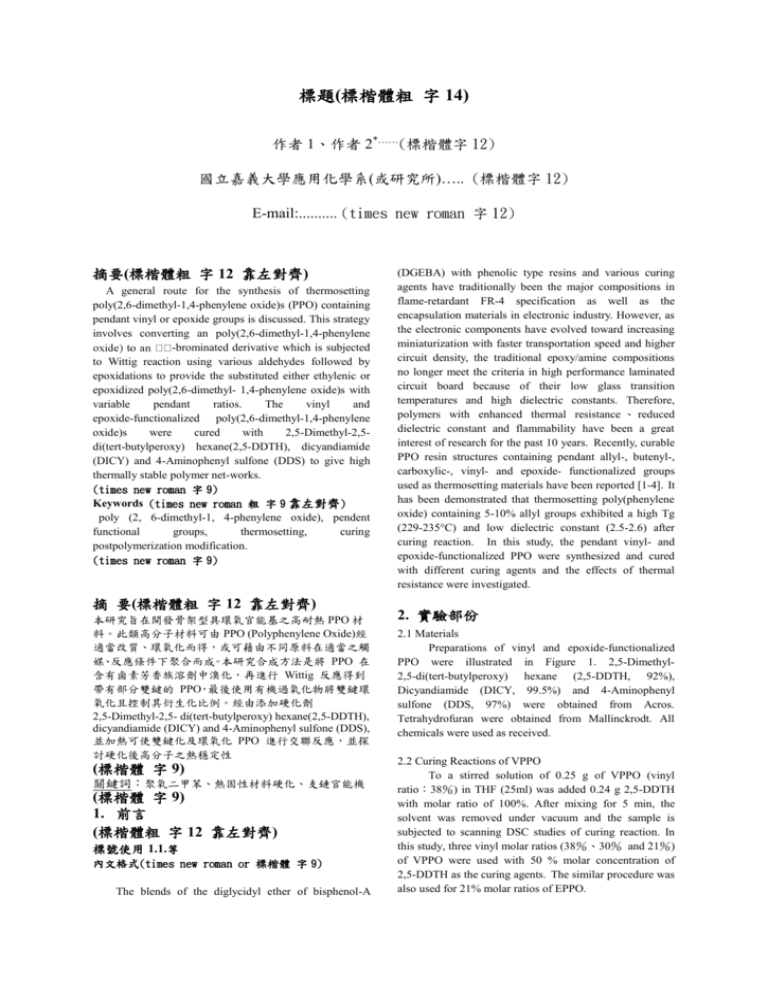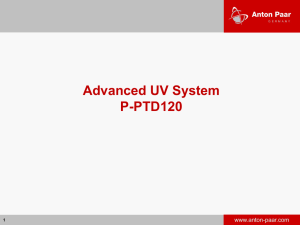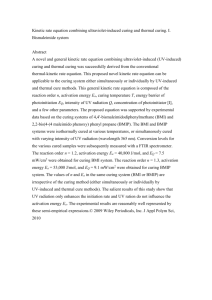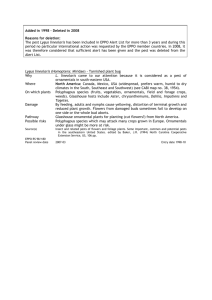DOC - 國立嘉義大學
advertisement

標題(標楷體粗 字 14) 作者 1、作者 2*……(標楷體字 12) 國立嘉義大學應用化學系(或研究所)….. (標楷體字 12) E-mail:.......... (times new roman 字 12) 摘要(標楷體粗 字 12 靠左對齊) A general route for the synthesis of thermosetting poly(2,6-dimethyl-1,4-phenylene oxide)s (PPO) containing pendant vinyl or epoxide groups is discussed. This strategy involves converting an poly(2,6-dimethyl-1,4-phenylene -brominated derivative which is subjected to Wittig reaction using various aldehydes followed by epoxidations to provide the substituted either ethylenic or epoxidized poly(2,6-dimethyl- 1,4-phenylene oxide)s with variable pendant ratios. The vinyl and epoxide-functionalized poly(2,6-dimethyl-1,4-phenylene oxide)s were cured with 2,5-Dimethyl-2,5di(tert-butylperoxy) hexane(2,5-DDTH), dicyandiamide (DICY) and 4-Aminophenyl sulfone (DDS) to give high thermally stable polymer net-works. (times new roman 字 9) Keywords (times new roman 粗 字 9 靠左對齊) poly (2, 6-dimethyl-1, 4-phenylene oxide), pendent functional groups, thermosetting, curing postpolymerization modification. (times new roman 字 9) 摘 要(標楷體粗 字 12 靠左對齊) 本研究旨在開發骨架型具環氧官能基之高耐熱 PPO 材 料。此類高分子材料可由 PPO (Polyphenylene Oxide)經 適當改質、環氧化而得,或可藉由不同原料在適當之觸 媒、反應條件下聚合而成。本研究合成方法是將 PPO 在 含有鹵素芳香族溶劑中溴化,再進行 Wittig 反應得到 帶有部分雙鍵的 PPO,最後使用有機過氧化物將雙鍵環 氧化且控制其衍生化比例。經由添加硬化劑 2,5-Dimethyl-2,5- di(tert-butylperoxy) hexane(2,5-DDTH), dicyandiamide (DICY) and 4-Aminophenyl sulfone (DDS), 並加熱可使雙鍵化及環氧化 PPO 進行交聯反應,並探 討硬化後高分子之熱穩定性 (標楷體 字 9) 關鍵詞:聚氧二甲苯、熱固性材料硬化、支鏈官能機 (標楷體 字 9) 1. 前言 (標楷體粗 字 12 靠左對齊) 標號使用 1.1.等 內文格式(times new roman or 標楷體 字 9) The blends of the diglycidyl ether of bisphenol-A (DGEBA) with phenolic type resins and various curing agents have traditionally been the major compositions in flame-retardant FR-4 specification as well as the encapsulation materials in electronic industry. However, as the electronic components have evolved toward increasing miniaturization with faster transportation speed and higher circuit density, the traditional epoxy/amine compositions no longer meet the criteria in high performance laminated circuit board because of their low glass transition temperatures and high dielectric constants. Therefore, polymers with enhanced thermal resistance 、 reduced dielectric constant and flammability have been a great interest of research for the past 10 years. Recently, curable PPO resin structures containing pendant allyl-, butenyl-, carboxylic-, vinyl- and epoxide- functionalized groups used as thermosetting materials have been reported [1-4]. It has been demonstrated that thermosetting poly(phenylene oxide) containing 5-10% allyl groups exhibited a high Tg (229-235°C) and low dielectric constant (2.5-2.6) after curing reaction. In this study, the pendant vinyl- and epoxide-functionalized PPO were synthesized and cured with different curing agents and the effects of thermal resistance were investigated. 2. 實驗部份 2.1 Materials Preparations of vinyl and epoxide-functionalized PPO were illustrated in Figure 1. 2,5-Dimethyl2,5-di(tert-butylperoxy) hexane (2,5-DDTH, 92%), Dicyandiamide (DICY, 99.5%) and 4-Aminophenyl sulfone (DDS, 97%) were obtained from Acros. Tetrahydrofuran were obtained from Mallinckrodt. All chemicals were used as received. 2.2 Curing Reactions of VPPO To a stirred solution of 0.25 g of VPPO (vinyl ratio:38%) in THF (25ml) was added 0.24 g 2,5-DDTH with molar ratio of 100%. After mixing for 5 min, the solvent was removed under vacuum and the sample is subjected to scanning DSC studies of curing reaction. In this study, three vinyl molar ratios (38%、30% and 21%) of VPPO were used with 50 % molar concentration of 2,5-DDTH as the curing agents. The similar procedure was also used for 21% molar ratios of EPPO. 2.3. Curing Reactions of EPPO EPPO (0.2 g, epoxy ratio:28%) was dissolved in 20 ml THF. Subsequently, DICY (0.018 g) or DDS (0.054 g) was added with molar ratio of 50%. After mixing for 10 min, the solvent was was removed under vacuum and the sample is subjected to scanning DSC studies of curing reaction. In this study, two molar ratios (28%、20%) of EPPO were used with 50 % molar concentration of DDS、DICY and 2,5-DDTH as the curing agents. 2.4. Measurements 1H and 13C NMR spectra were recorded on a 300 and 75 MHz Varian – Mercury+ 300 spectrometer, respectively, using the CDCl3 solvent and the internal standard tetramethylsilane. Fourier transform infrared spectroscopy (FTIR) spectra were recorded for KBr disks using a Shimadzu FT-IR 8400 spectrometer. The molecular weight of the polymers was determined by gel permeation chromatography (GPC) which was carried out with polymer solutions in THF.Differential scanning calorimetry (DSC) measurements were performed on a DSC Q10 differential scanning calorimeter (TA Instruments). The instrument was calibrated with high-purity indium as a standard. All samples (<10 mg) were contained within sealed aluminum DSC pans. The sample was heated at a rate of 10℃/min to 320℃, cooled to 40℃, and heated again. The nitrogen gas flow was 50 mL/min. A first scanning run was performed on all cured samples to obtain their enthalpy and temperature (onset、 maximum peak and end) of curing reaction. A second scanning run was performed on all cured samples to obtain their glass transition temperature (Tg) by the TA software. Thermogravimetric analysis (TGA) was performed with a TGA Q50 (TA instrument) thermogravimetric analyzer under a nitrogen atmosphere. Samples (10–15 mg) were placed in platinum pansand put in an oven at 30℃. Heating scans were carried out from 30 to 800℃ at 10℃/min. Nickel was used for calibration. The temperatures of 5% weight loss and the residue were measured in comparison with the original epoxy analogues. 3. 結果與討論 3.1. Polymer synthesis Various molar ratios of pendant vinyl functionalized polyphenylene oxides were prepared in three steps from polyphenylene oxides according to the procedure as shown in Figure 1. Treatment of vinyl-substituted polymers with m-chloroperbenzoic acid led to the formation of epoxidized poly(2,6-dimethyl- 1,4-phenylene oxide) with epoxide molar content ranging from 34% (EPPO2) to 18% (EPPO3). Different reagents have been used to perform -bromination of alkylbenzenes under heating or irradiation of light, such as bromine [5-7], NBS [8-11] and some relevant concerns are the effects of solvents [12], catalysts [13-16] and the selectivity between radical substitutions on side chain or electrophilic substitution on aromatic ring [18]. Since N-bromosuccinimide is a popular reagent employed mostly in free radical allylic and benzylic brominations, we focused on the use of NBS. The partially methyl-brominated polymers were obtained in excellent selectivity at high yields and hardly any phenyl-brominated or methyl-dibrominated derivatives was found after isolation. Treatment of methyl-dibrominated polymers with triphenylphosphine followed by addition of various aldehydes in the presence of sodium hydroxide led to the formation of vinyl-substituted poly(2,6-dimethyl1,4-phenylene oxide) with different alkyl or aryl substituents. The degree of functionalization (m%) can be determined by comparing the area of average integral of vinyl or epoxide concentration with the total area of aromatic protons on polymer backbone. Table 1 shows the synthesis and thermal stability of pendant-functionalized PPO polymers. The GPC chromatographs of all bromo-, vinyl- and epoxide-pendant polymers showed unimodal peaks and the fact that the resulting vinyl-pendant polymers generally displayed higher molecular weights than their brominated and epoxide analogues revealed that certain extent of crosslinking reaction occurred during the course of Wittig reaction. No GPC data was obtained for 4a because of the limited solubility of the formaldehyde-derived polymers. However, by increasing the chain length of the aldehyde, the solubility of EPPO in tetrahydrofurane was improved and the molecular weight measurements were accessible. It was found in TGA thermograms that the 5% weight loss temperatures of VPPO were higher than those of EPPO and BPPO polymers. The higher thermal stability of VPPO might be attributed to ortho-substituted vinyl groups which possess a higher conformational energy barrier and restrict the rotational freedom. Another possible explanation for the increment of Td,5% could be due to the presence of cross-linked structure in VPPO. TGA thermograms of VPPO and EPPO under nitrogen were shown in Figure 2 and 3, respectively. 3.2. Curing behaviors of VPPO and EPPO The thermal curings of the EPPO polymer (4a), examined with DSC, were presented in Figure 4. The exothermic transitions can be characterized by Tonset (the first detectable heat, obtained by the extrapolation of the steepest portion of the curve), Tp (the peak exotherm temperature) and Tf (the temperature of the end of the curing, obtained by the extrapolation of the curve) and the results are listed in Table 2. The thermal stabilities of both cured and uncured VPPO and EPPO polymers were examined by TGA and the values of Td,5% were summarized in Table 2. It is observed that DICY reacts with epoxide PPO at a faster rate (i.e., lower-temperature range) than does DDS and 2,5-DDTH; however, the order of thermal stability of the cured polymer is in the opposite direction as shown in Table 2. The homopolymerization of pristine EPPO occurred at about 260℃ which might be due to the residual acid from epoxidation reaction and initiated crosslinking reaction upon heating. Compared with the neat EPPO curing behavior, the exothermal peaks for DICY, DDS and 2,5-DDTH showed an decrease of curing temperature by approximately 60 to 100℃. It is noteworthy that a significant increase in thermal stability is obtained (79-137°C, based on Td,5%) after curing reaction compared to the original epoxy analogues. The thermal stability of the cured VPPO generally exhibited better thermal stability than the cured epoxy analogues despite the less increments of Td,5% after curing reactions. The DDS-cured polymers generally displayed a better thermal stability than the DICY-cured polymers probably because of the rigidness of the sulfone structure. 4. 畢業感言 PPO Table 1. Synthesis and thermal stability of pandentfunctionalized PPO polymers Polymer yield Mn Mw Td,5% Char % 2a 91% 18403 44642 291 43 3a 81% 24532 49316 394 36 3b 79% 28354 88661 391 38 3c 73% 27734 64023 381 30 3d 91% 17791 52721 400 47 4a 76% - - 296 49 4b 60% 15286 55523 297 50 4c 63% 18505 67515 287 40 4d 87% 13293 51510 269 32 5. 參考文獻 格式 1.姓, 名縮寫. ; 格式姓, 名縮寫. 期刊名, 年份, 刊數 , 起始頁-結束頁 1. Merfeld, G. D.; Yeager, G. W.; Chao, H. S.; Singh, N. Polymer 2003, 44, 4981-4990 Figure 2. TGA thermograms of the VPPOs 圖表格式 圖表編號:內文為中文請使用”圖一” ”表一” 內文為英文使用”figure 1.” ”table 1. ” CH3 CH3 CH2Br NBS, hv O CH3 O CH3 n 1 O CH3 n-m m 2 H CH3 R C C H 1. PPh3, toluene O O 2. RCHO, NaOH, MeOH CH3 CH3 n-m m 3 O H CH3 C R C H MCPBA O CHCl3 CH3 Figure 3. TGA thermograms of the EPPOs O n-m CH3 m 4 a:R= H; b: R= n-propyl; c: R= n-butyl; d:R= -C6H5 Figure 1. Preparation of vinyl and epoxide-functionalized Figure 4. Effect of curing agent on the cure of EPPOs. Table 2. Thermal Analysis Data for the curing of VPPO and EPPO Polymers Polymer Curing Agent m% Tonset (℃) Tp (℃) Tf (℃) T5%,d(before) (℃) T5%,d(after)(℃) Char % 3a 2,5-DDTH 38 131 187 239 378 416 39 3a 2,5-DDTH 30 137 190 230 393 407 37 3a 2,5-DDTH 21 145 196 233 398 414 37 4a DICY 28 93 152 162 253 352 35 4a DDS 28 83 155 168 253 359 45 4a 2,5-DDTH 28 135 192 218 253 390 42 4a DICY 20 74 138 160 256 335 36 4a DDS 20 104 158 174 256 360 41 4a 2,5-DDTH 20 130 194 218 256 389 39








